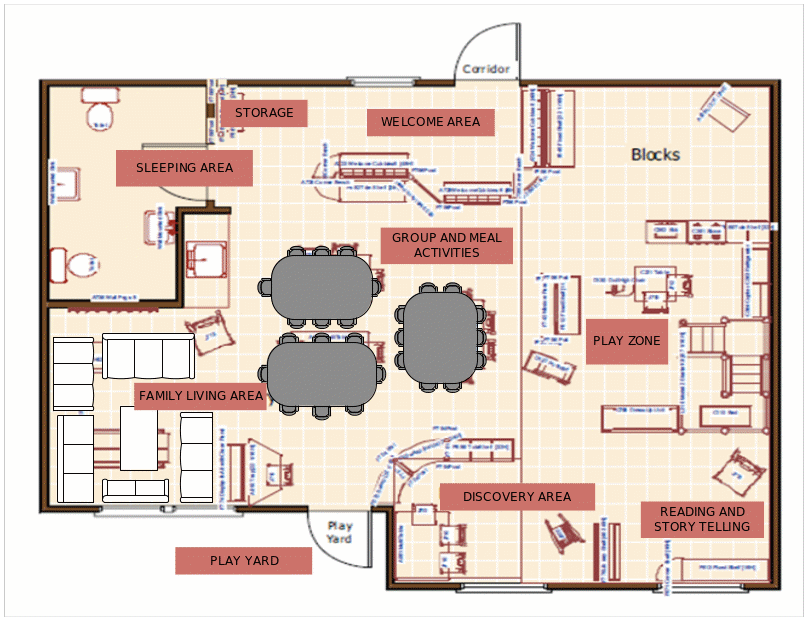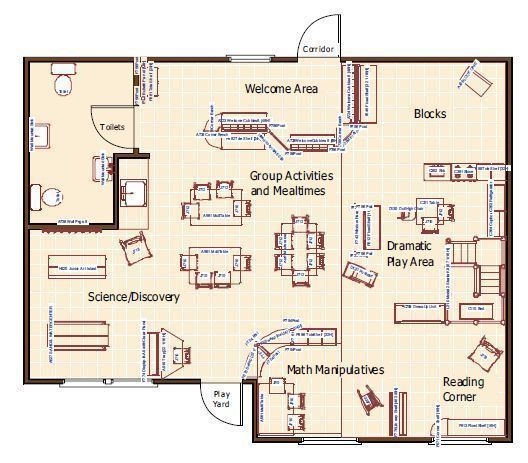Toddler classroom layout
The classroom environment for children should essentially create a safe and healthy environment for child’s development. Exposure to situations that might cause injury and ill health must be kept at minimal. Based on project constructivism, the environment must be able to offer an environment where children can exercise creativity and learn from the environment presented to them.
Rituals and routines must be meaningfully considered in design of the classroom. These include diapering, sleeping, and playing. Other areas considered included interest centers, outdoor places, adult places, personal storage, eating spaces, moving, and climbing places, messy places, and soft spaces. Diapering area should have enough space to enable everything to be within reach including sink, diapers, baby lotions, salves, and extra baby clothing ( Dudek 47). Additionally, infants belonging should be located in places where parents can easily locate them. Additionally, diapers should be changed in privacy while at the same time the caretaker maintains view of the others. Sleep and play areas should be separately located.
Soft spaces should be provided to the infants. This offers the comfort and security in addition to absorbing sound within the room thereby limiting noise. The staff should also have comfortable sitting places (Kelly 56). A couch or easy chairs should be availed for them. Messy places allow children to play with various things like sand, artworks, among others. This area needs to be spacious, safe, and non-toxic. Infants and toddlers undergo various developmental stages and hence the need for more challenging activities. This is catered for through provision of spaces for movement and climbing. The eating-place must also be considered. Toddlers should be relaxed and allowed social interactions space during eating. Space for children’s personal storage should be availed to allow children to have a sense of security. Adult centers where parents and teachers discuss children’s issues and outside area where children can take breeze is considered. Among the items availed in the classroom for children include Furniture, Lofts, Climbers, pits, large blocks, balls, tunnels, and push and pull toys( Dudek 37). The diagram below indicates a proposed classroom design for toddlers.

Preschool Classroom, Licensed For 20 Children
Pre-school children are very active and relatively difficult to control. Each uniquely identifies with the environment and tends to want to have their will. Open structure classrooms allow the children to choose which activities they engage in. design of such often aims to foster children’s natural interests and their impulse utilization to their advantage. The room is supposed to be designed in such a way that children feel at home and hence develop routine disciplines. Boundaries need to be well defined and play/sitting surfaces are appropriate for the activities they are intended to support. Each activity area should have an appropriate storage area for its materials. The mood of the area must also be made to be in line with functions intended for that area.

In conclusion, it is important to reiterate that classroom design entails more than simple beautification and creation of a room for children to learn. The room must be able to interact with the pupils positively. Pupils must identify with the room and b able to interpret what it represents. In addition, the children must be able to feel comfortable and free enough within the environment. Space requirements must be considered to allow free movement from one area to another without increasing possibility of injuries. It would be senseless if a room is beautiful but fails to capture the creativity and learning potential within the children, play yards need to be availed for the children to break the indoor monotony and be able to feel the free air from an external environment. Every design must take into consideration the welfare and requirement f all the stakeholders involved including parents, teachers, and regulatory authorities, but most importantly the children. Technology changes also need to be embedded into modern-day classroom layouts, noting that the world of today has undergone milestone changes compared to ten years ago. The layouts designed attempt to maximally ensure that children have an opportunity to interact with the environment and hence learn from and develop innovative ideas.
Choosing a curriculum
Early childhood teaching is a rather tricky area. It is believed that curriculum offers strategic and systematic approach to early childhood teaching. Curriculum integration should be based on high standards of quality, professional background development and connection ability to teaching resources (Kelly 41). This should give rise to an round program that addresses the needs of all early childhood stakeholders involved. The stakeholders include the teachers, the children, their families, and regulatory authorities (Olds 103). Curriculum development is diverse and this has led to existence of a number of approaches including the high scope, project construct, and creative curriculum. These approaches dictate the earning environment setting employed by the institution/teacher.
Developed by the Missouri department of elementary and secondary education, project constructs draw plenty of interest. Currently the curriculum is implemented in more than 212 Missouri school districts. Likewise, project construct curriculum is implemented in other states school districts. Its curriculum and assessment framework is based on continuous field-testing and participating educators’ inputs. It is generally defined as a rigorous curriculum that is contextualized and centered more on the learner. It offers students opportunity to explore the environment, test their ideas, investigate possibilities through experiments and observation, and develop new strategies. The children are able to apply the knowledge they gain to situational cases (Kelly 49). The constructivist theory, upon which it is based, states that children hold ability to construct their independent knowledge and values based on their physical and social world interaction. Implementation of project construct is based on various beliefs with regard to learning namely:
- Human minds naturally classify, organize, interpret, and represent the environment it meets. This makes learning a constructive problem undergoing continuous development.
- Communication, reflection, and collaboration foster the learning process. Classroom is recognized, as a sub-society constituted of a diverse learning community engaging in constructive learning process.
- Development and academic domains are interrelated and interact with each other.
Based on this theory, educators have an obligation of applying the knowledge they have on children’s development to facilitate individual children’s social and conceptual development. Curriculum forms the foundations upon which classrooms are constructed and designed. It is important to acknowledge that project construct curriculum recognizes that each age group has different requirements and uniquely interacts with the environment (Olds 103). Though each child is unique, often the way children of the same age group react to the environment tends to be similar in nature. Developing a classroom layout is a rather challenging task and a number of factors have to be considered.
‘Project construct’ values and respects every child as a pupil and as an individual. The teacher supports the children to develop ideas as individuals (Goffin127). The teacher uses the interest of the pupils interest in encouraging them to learn, collaborate with one another, and take initiatives that allow them express their opinions and engage in constructive decision-making. Learner’s errors are viewed as opportunities for them to learn (Olds 108). In this model, classroom arrangement/environment is viewed as a learning tool. It therefore entails careful design and scheduling of daily activities with respect to classroom environment (Goffin156). Assessment of children is based on the activities they engage in, how creative they are and the ideas they develop. Students display their work and are graded based on how creative their work is. This gives them sense of ownership of the classroom with their work all around.
Project construct is chosen because of the plenty of advantages it presents to the children. It prepares them for assessment criteria resented by the new academic standards. It builds their confidence and prepares them to become more realistic problem solvers. Children develop deep understanding of real-life problem-solving techniques. They also develop critical thinking skills and learn to cooperate thus developing their team-building capacity.
Works Cited
Dudek, Morris. Building for Young Children, London: Chapman Publishing.2000, 24-59.
Kelly, Avril. (eds) Early Childhood Education: A Developmental Curriculum. London: Sage Publications. 2005, 32-60.
Olds, Andy. “Child Care Design Guide,” London: McGraw-Hill, 2000, 98 -116.
Goffin, Stacie. “Project Construct, a curriculum guide: understanding the possibilities.” London: Missouri Dept. of Elementary and Secondary Education, 1992, 111-189.